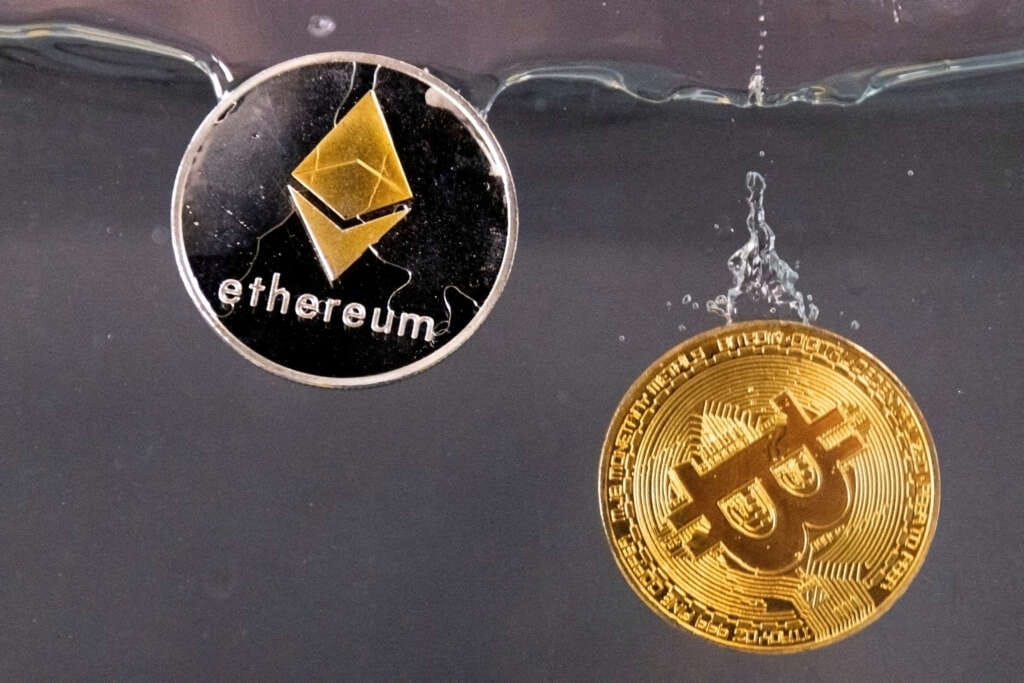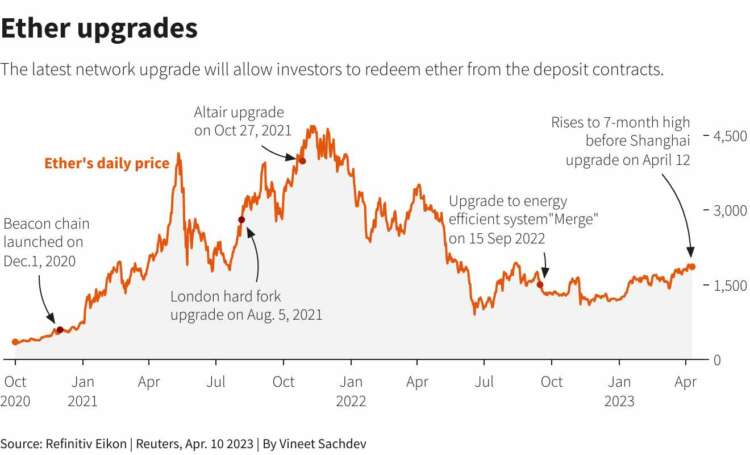
By Medha Singh and Lisa Pauline Mattackal
(Reuters) – Investors are finally set to gain access to more than $33 billion of ether this week under a planned revamp of the blockchain.
A new software upgrade to the Ethereum blockchain, dubbed Shapella, will let market players redeem their “staked ether” – coins they have deposited and locked up on the network over the past three years in return for interest.
About 15% of all ether is staked, totaling $33.73 billion in market value, according to data from Dune Analytics.
Up to 1.1 million ether will be ready for withdrawals in the week following the revamp of the blockchain, estimated Sreejith Das, CEO at Attestant, a company that facilitates the staking of ether. That would be worth nearly $2 billion, based on the latest ether price of about $1,860.
Traders hunting an edge are now trying to figure out how this sudden ether windfall might hit prices. It’s difficult to judge though, said Robert Quartly-Janeiro, chief strategy officer at crypto exchange Bitrue.
“The only thing certain is that the Shanghai hard fork will bring about some short-term volatility,” he added.
Some corners of the market are worried that unlocking staked coins could lead to massive withdrawals and a wave of selling, which could push prices rapidly lower.
Yet only about 29% of all ether staked by volume is currently in profit in dollar terms, which would mean most would be sold at a loss, according to Bundeep Rangar, CEO of blockchain investment firm Fineqia International.
“It seems unlikely, therefore, that much of the staked ether will be sold,” Rangar added.
(Graphic: Ether upgrades – https://www.reuters.com/graphics/FINTECH-CRYPTO/WEEKLY/xmvjkjlmxpr/chart.png)

‘FINAL PIECE OF THE PUZZLE’
Shapella would mark the end of a long wait for investors who had opted to deposit ether in exchange for a yield since the staking project began in 2020.
Ethereum developers paved the way for this development with a major upgrade called the “Merge” last year, which ditched energy-intensive mining and moving to a “proof-of-stake” system where ether owners lock up 32 coins to check new records on the blockchain, earning new ether on top of their “staked” coins.
Until the planned revamp this week, investors looking to stake coins had to deposit a minimum of 32 ether at a time (worth $59,520 at current prices) for an indefinite period, a hefty sum beyond the reach of an average retail investor.
“Before Shanghai, a lot of people and institutions probably chose not to stake their ether because, once they did, it would have been locked up for an undefined period of time, which was risky,” said Dave Weisberger, CEO of digital assets trading platform CoinRoutes.
Following the upgrade, staked ether will no longer be locked up on the blockchain, so investors may be more willing to stake coins.
The market value of tokens behind projects like Lido Finance and Rocket Pool, some of the largest projects providing liquidity for crypto staking, have soared nearly six times to $2 billion and four times to $875 million respectively this year, according to CoinMarketCap, on expectations of further growth.
“It is likely that in the long term the amount of ether staked will increase, especially in comparison with the percentage of supply staked for other digital assets such as Solana, Mathic and Ada,” said Rangar at Fineqia.
So what manner of investors are likely to enter the market following the changes wrought by Shapella?
“It will be those institutions that have sat on the side lines, silently waiting for this final piece of the puzzle to be put in place, the ones that needed the ability to withdraw their ether before they were allowed to stake it,” said Das at Attestant.
(Reporting by Medha Singh and Lisa Pauline Mattackal in Bengaluru; Editing by Pravin Char)


